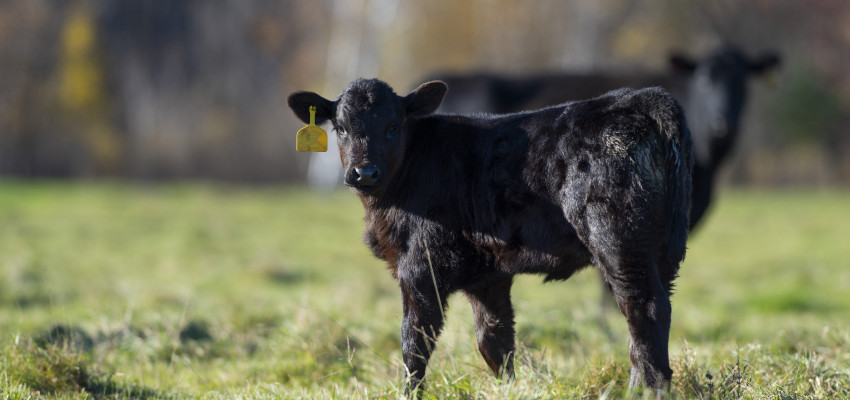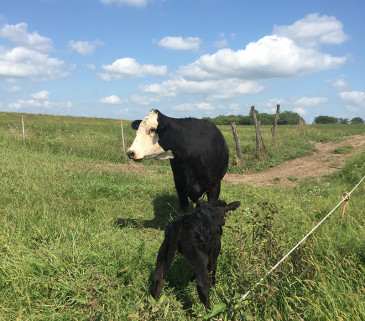By Kelsey Pagel on September 24, 2019
Fall on the Farm

Fall season on our farm means my husband, Matt, and I are all about our cow herd.
We have three groups of cattle on our farm. Cows have babies once per year, approximately. One of our groups have their babies starting in February, another in April-May and the last in the fall.
My typical routine of checking the cows twice a week transitions into checking them more often in August. I monitor the cows to see how close I think they are to having their babies (calving) and check them more often, depending on the analysis. I had been checking the cows once per day for about three days, before the first baby arrived. After that, I check the cows at least twice a day until all the cows are done calving. Checking the cows ensures safe deliveries for the mom and calf.
What do I look for when I check the calving cows? Like moms checking to make sure their kids’ backpack is stocked appropriately, I check the cows for several things:
Are there new babies? If so, have they eaten? If they have and appear to be doing well, I tag them. All our cows have a tag with a specific number. We do this so we can identify which calf belongs to which cow. On that tag, I write the cow’s number, but also write the date the calf was born, and our brand goes on the back of the tag. It’s nice to be able to easily identify when the baby was born later in their lives without having to refer to my paperwork. If the cattle ever get out, we want them to be easily identifiable so people can call us to get them back in – hence the reason for the brand.
Next, I check on the rest of the rest of the cattle. I count to ensure everybody is present, and make sure they have plenty of grass, water and protection. I also make sure they have mineral. Just like humans, ranchers supplement cattle’s diets with minerals and nutrients they aren’t getting from natural forages.
 I have a backpack I take on the four-wheeler with me while calving. In the backpack I have:
I have a backpack I take on the four-wheeler with me while calving. In the backpack I have:
- Tags
- Tagger (what I put the tags in with)
- A special marker to write on the tags. These markers are designed to outlast the weather and elements. We need to be able to read the tag for a very long time.
- Gloves and birthing assisting instruments in case we need to help a cow
- Pliers (because cows get out and I fix fences occasionally)
- Binoculars (in case I need to wait for a cow having a baby. I can give her considerable space, but keep a close eye on her.)
- I keep fly spray and a bucket of the cows’ favorite treats. Our cows are partial to wheat midds, which are packed full of protein and the cows think they are an amazing treat.
In the truck, I have a list of all the cows and write the date they had their baby, what the calf looks like and whether I could tag the baby or not. This helps me keep track of who has a baby and how many we’re waiting on to calf. I do all of this by myself most days.
 Some of the cows are more protective of their babies and it isn’t smart for me to try to catch the calf. I could get hurt in the process. We have raised most of our cattle or had them in the herd for several years. Most know the process and trust me since I’m with them so often. There are always a few though, I remain leery of. If I can’t get them tagged when they are a baby, we tag them when we give the babies their vaccines later in the fall. It is all noted in my cow notebook.
Some of the cows are more protective of their babies and it isn’t smart for me to try to catch the calf. I could get hurt in the process. We have raised most of our cattle or had them in the herd for several years. Most know the process and trust me since I’m with them so often. There are always a few though, I remain leery of. If I can’t get them tagged when they are a baby, we tag them when we give the babies their vaccines later in the fall. It is all noted in my cow notebook.
Calving season is always a fun time of year, but also very stressful - just like back-to-school season. We should wrap up most of the fall calving by the middle of October, but until then, I will continue checking the cows at least twice a day.
As we all settle into new routines and schedules – whether you’re a mom rushing to get your kid to school or me checking our “kids” (cows) often to make sure they are having healthy babies – may we be patient with each other and offer kindness.


